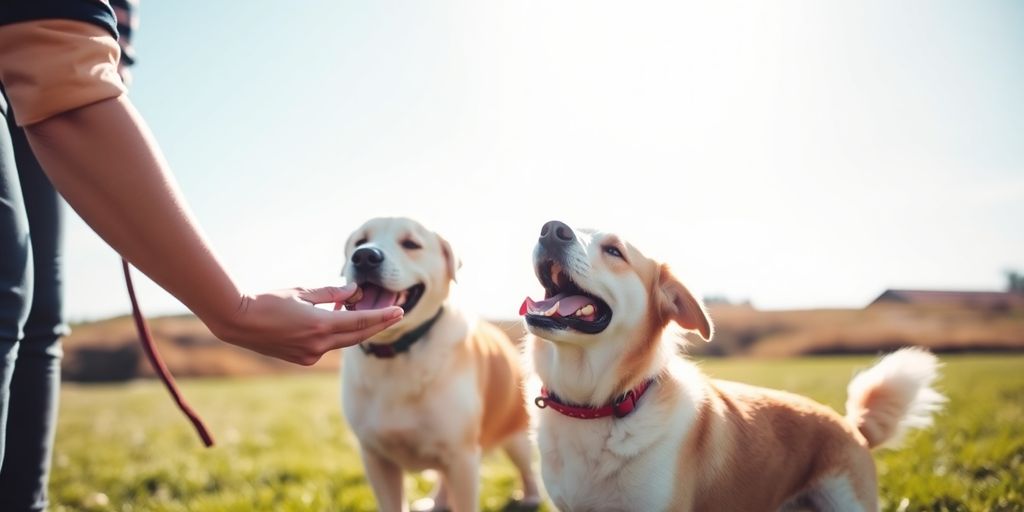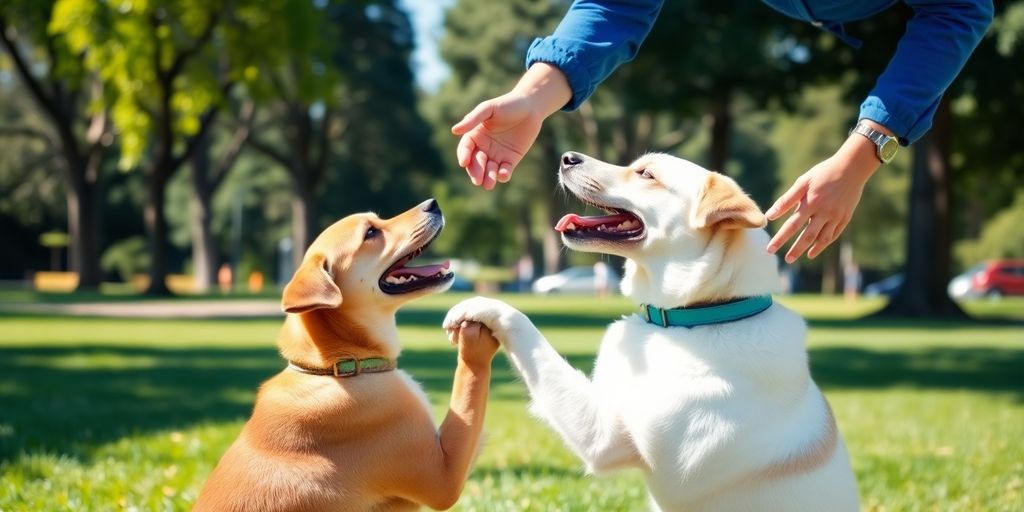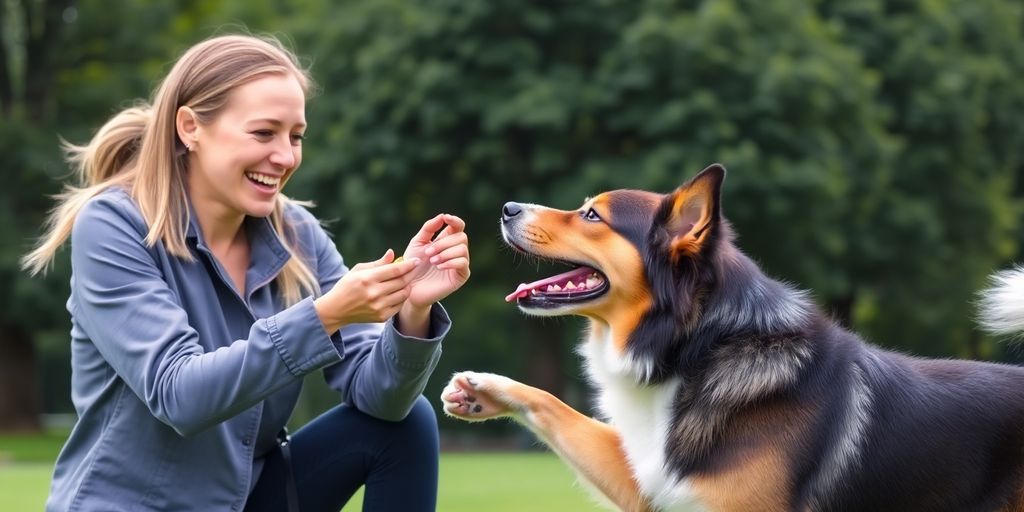 7 Apr
7 AprEssential Tips for Effective Dog Training: A Guide for Pet Owners
Training your dog can feel overwhelming at first, but it doesn’t have to be. With the right approach and a little patience, you can teach your furry friend how to behave well and respond to commands. This guide offers essential tips for effective dog training, ensuring you and your pet can enjoy a strong bond built on trust and understanding. Whether you’re a new pet owner or looking to refine your skills, these tips will help you on your training journey.
Key Takeaways
Always use positive reinforcement to encourage good behavior.
Be consistent with commands and cues to avoid confusing your dog.
Keep training sessions short and frequent for better results.
Incorporate training into daily activities for more practice.
Don’t hesitate to seek help from a professional trainer if needed.
Understanding Dog Training Basics

So, you’ve got a new furry friend? Awesome! But before you get lost in cuddles and playtime, let’s talk training. It’s not just about teaching your dog to sit or stay; it’s about building a solid relationship and ensuring they’re a well-adjusted member of society (dog society, that is!). Training helps prevent behavioral problems down the road, like excessive barking or chewing your favorite shoes. Think of it as an investment in a happy, harmonious life together. Plus, a trained dog is a safer dog, especially in unpredictable situations.

Common Training Myths
Okay, let’s bust some myths. One big one is that puppy training is only for puppies. Nope! Dogs of any age can learn new tricks. Another myth? That you need to be super strict or dominant. Modern training is all about positive reinforcement and building trust, not fear. And forget the idea that some breeds are untrainable. Every dog is an individual, and with the right approach, they can all learn.
Different Training Methods
There are tons of ways to train a dog, so find what works best for you and your pup. Obedience training is a classic, focusing on basic commands. Agility training is great for energetic dogs who need a challenge. Clicker training uses a distinct sound to mark desired behaviors. And don’t forget crate training, which can provide your dog with a safe and secure den. The key is to be patient, consistent, and positive, and to tailor your approach to your dog’s personality and learning style.
Training isn’t just about teaching commands; it’s about communication and understanding. It’s about creating a bond where your dog trusts you and wants to please you. It’s a journey, not a destination, so enjoy the process!
Establishing a Positive Training Environment
Creating a Distraction-Free Space
When you’re starting out with dog training, think about where you’re doing it. A quiet place is key. Turn off the TV, put away toys, and maybe even close the curtains. The goal is to minimize anything that might steal your dog’s attention. As your dog gets better at focusing, you can slowly introduce distractions, but in the beginning, keep it simple. This helps them learn faster and avoids frustration for both of you.
Using Positive Reinforcement
Positive reinforcement training is all about rewarding good behavior. Forget about punishment; it’s way more effective to focus on what your dog does right. This could be with treats, praise, or a favorite toy. The trick is to find out what motivates your dog the most. Some dogs are food-crazy, while others just want a good belly rub. When they do something you like, reward them immediately. This helps them connect the action with the reward, making them more likely to repeat it.
Positive reinforcement isn’t just about giving treats. It’s about building a relationship based on trust and encouragement. When your dog knows that good things happen when they listen to you, they’ll be much more eager to learn.
Setting Realistic Expectations
It’s important to remember that every dog learns at their own pace. Don’t expect your dog to become a perfectly obedient robot overnight. Be patient, and celebrate small victories. If your dog masters “sit” one day, that’s awesome! Don’t get discouraged if they struggle with “stay” the next day. Keep training sessions short and fun, and always end on a positive note. If you get frustrated, your dog will pick up on it, and it will make training harder. Remember, it’s a journey, not a race.
Effective Communication with Your Dog

Verbal Cues and Commands
Okay, so you’re talking to your dog, but is your dog really understanding you? It’s more than just saying words; it’s about creating a clear connection. Use short, simple commands. Think “sit,” “stay,” “come.” Avoid long sentences that can confuse your furry friend. Consistency is key. If “sit” sometimes means “lie down,” your dog will get mixed signals. Make sure everyone in the house uses the same commands. It’s like learning a new language, and your dog is the student. Be patient, and repeat the commands often.
Body Language and Signals
Dogs are masters at reading body language. They pick up on subtle cues that we often miss. Your posture, hand gestures, and even your facial expressions can communicate a lot. For example, leaning forward might signal excitement, while standing tall and still could indicate authority. Pay attention to your dog’s perspective. Are you unintentionally luring them out of a “stay” position with your body? A relaxed posture can help your dog feel more secure. Be mindful of your movements and how they might be interpreted. It’s a two-way street; learn to read your dog’s body language too. Are they showing signs of stress, like panting or lip-licking? Understanding their signals will improve your communication and strengthen your bond.
Consistency in Commands
Imagine trying to learn a new skill when the rules keep changing. Frustrating, right? That’s how it feels for your dog when commands aren’t consistent. If “no” means one thing today and something else tomorrow, your dog will struggle to understand. Consistency is the cornerstone of effective communication. Use the same words, the same tone, and the same body language every time you give a command. Don’t allow jumping on you in sweatpants if you don’t want it when you’re in work clothes. This prevents confusion and helps your dog learn faster. It’s also important to be consistent with rewards. If your dog performs a command correctly, reward them every time, at least initially. This reinforces the desired behavior and makes training more effective.
Consistency isn’t just about repeating the same words; it’s about creating a predictable environment where your dog feels safe and understood. When your dog knows what to expect, they’re more likely to listen and respond positively.
Incorporating Training into Daily Life

Training During Walks
Walks are a fantastic opportunity to reinforce training. Instead of just letting your dog pull on the leash, use the time to practice loose-leash walking. Ask for a “sit” at street corners, or work on recall in a safe, open space. The key is to make training a natural part of your routine, not a separate chore. Vary the environment to help your dog generalize commands. A “sit” at home should mean the same as a “sit” at the park!
Using Meal Times for Training
Meal times can be more than just filling the bowl. Before giving your dog their food, ask them to perform a command like “sit,” “stay,” or “down.” This turns mealtime into a mini-training session and reinforces the idea that they need to earn their rewards. It’s a great way to keep their mind engaged and focused, especially for food-motivated dogs. You can even use their kibble as training treats during these sessions.
Making Training Fun and Engaging
Training shouldn’t feel like a chore for either of you. Keep it positive, upbeat, and full of praise. Incorporate games and play into your training sessions to keep your dog motivated and excited. Short, frequent sessions are much more effective than long, drawn-out ones. End each session on a positive note, leaving your dog wanting more. Remember, a happy dog learns better!
Training should be a positive experience for both you and your dog. If you find yourself getting frustrated, take a break. The goal is to build a strong bond and a well-behaved companion, not to create stress and resentment.
Building a Strong Bond Through Training
Training isn’t just about teaching your dog to sit or stay; it’s a fantastic way to deepen your connection. It’s about understanding each other better and building a relationship based on trust and mutual respect. Plus, it’s fun! Who doesn’t love showing off a well-behaved pup?
The Role of Trust in Training
Trust is everything in dog training. If your dog doesn’t trust you, they won’t be receptive to learning. It’s like trying to teach someone who doesn’t believe in you – it’s an uphill battle. Build trust by being consistent, fair, and patient. Avoid punishment, which can damage your relationship and make your dog fearful. Instead, focus on positive reinforcement and creating a safe, supportive environment where your dog feels comfortable learning. Remember, a confident dog is a happy dog, and a happy dog is easier to train.
Celebrating Small Wins
It’s easy to get caught up in the big picture – wanting your dog to master complex commands or overcome challenging behaviors. But it’s important to celebrate the small victories along the way. Did your dog finally stop pulling on the leash for a few steps? Did they manage to stay calm when another dog walked by? Acknowledge and reward these moments, even if they seem insignificant. These small wins build confidence and motivation, both for you and your dog. Plus, it makes the whole process more enjoyable. Woof Houze offers various pricing options for obedience training, catering to different needs and budgets.
Understanding Your Dog's Perspective
Ever wonder why your dog isn’t “getting it”? Maybe you’re not seeing things from their point of view. Dogs don’t understand language the same way we do, so it’s important to be clear and consistent with your cues. Are you using the same hand signals and verbal commands every time? Is your body language conveying the message you intend? Sometimes, what seems obvious to us is completely confusing to our furry friends. Try to put yourself in their paws and see the world through their eyes. It can make a huge difference in your training success.
Training is a two-way street. It’s not just about teaching your dog what you want them to do; it’s about learning how they communicate and understanding their needs. When you approach training with empathy and patience, you’ll not only achieve better results but also build a stronger, more meaningful bond with your canine companion.
Troubleshooting Common Training Challenges
Identifying Behavioral Issues
Sometimes, what looks like disobedience is actually a deeper behavioral problem. Is your dog suddenly refusing commands they once knew? It could be due to anxiety, fear, or even a medical issue. Careful observation is key. Look for patterns: When does the behavior occur? What triggers it? Keeping a log can help you pinpoint the root cause. For example, a dog that suddenly becomes aggressive during Thanksgiving outings might be stressed by the noise and crowds.
Adjusting Training Techniques
Not all training techniques work for every dog. If you’re hitting a wall, it’s time to re-evaluate your approach. Are you using the right rewards? Is your timing off? Consistency is important, but so is flexibility. Try breaking down complex commands into smaller steps. Short, frequent sessions are often more effective than long, drawn-out ones. Remember to keep it positive and fun; training shouldn’t feel like a chore for either of you.
When to Seek Professional Help
There comes a time when you might need to call in the experts. If you’re dealing with aggression, severe anxiety, or other serious behavioral problems, don’t hesitate to consult a certified dog trainer or veterinary behaviorist. They can provide a personalized assessment and develop a tailored plan to address your dog’s specific needs. Consider joining training classes to get personalized feedback. A professional can also identify miscommunications or subtle cues you might be missing.
It’s easy to get frustrated when training isn’t going as planned, but remember that every dog learns at their own pace. Be patient, stay positive, and celebrate even the smallest victories. A little persistence can go a long way in building a happy, well-behaved companion.
Maintaining Progress and Continuing Education

The Importance of Ongoing Training
So, you’ve nailed the basics. Great! But think of dog training like learning a language. You can’t just stop after the beginner’s course and expect to be fluent forever. Ongoing training is key to reinforcing good behaviors and preventing your dog from slipping back into old habits. It’s also a fantastic way to keep their mind sharp and engaged. Plus, life changes – new house, new baby, new routines – and your dog needs to adapt. Regular training sessions help them handle these transitions smoothly. Think of it as a continuous conversation, not a one-time lecture.
Exploring Advanced Training Techniques
Ready to take things up a notch? Advanced training isn’t just about fancy tricks (though those are fun too!). It’s about deepening your communication and understanding with your dog. Consider exploring techniques like:
Agility training: Great for physical and mental stimulation.
Scent work: Taps into your dog’s natural instincts.
Trick training: Builds confidence and strengthens your bond.
Advanced obedience: Refines your dog’s responsiveness and control.
Don’t be afraid to experiment and find what you and your dog enjoy most. It’s all about making learning a fun and rewarding experience for both of you. You can find advanced training courses to help you with this.
Joining Training Classes or Groups
Training at home is awesome, but sometimes you need a little outside help. Joining a training class or group offers several benefits:
Socialization: Your dog gets to interact with other dogs in a controlled environment.
Expert guidance: A professional trainer can provide personalized feedback and address specific challenges.
Motivation: Being in a group setting can keep you and your dog motivated.
New ideas: You’ll learn from other owners and trainers.
It’s easy to get stuck in a rut when training alone. Classes and groups expose you to different perspectives and approaches, helping you become a more effective and adaptable trainer.
Consider these options:
Local dog training clubs
Community centers
Online training programs
To keep moving forward and learn more, it’s important to stay engaged and seek out new knowledge. Don’t forget to check out our website for helpful resources and tips that can support your journey. Let’s keep growing together!
Wrapping It Up
Training your dog doesn’t have to be a headache. With the right approach and a little patience, you can make it a fun experience for both of you. Remember, it’s all about consistency, positive reinforcement, and keeping things light. Celebrate the small wins, and don’t forget to see things from your dog’s perspective. If you hit a wall, don’t hesitate to reach out for help. Whether it’s a trainer or a class, getting some extra guidance can make a world of difference. So, take a deep breath, enjoy the process, and watch your furry friend thrive!
Frequently Asked Questions
Begin with simple commands like 'sit' or 'stay' in a quiet space. Use treats or praise to reward your dog when they follow your command.
Keep training sessions short, around 5 to 10 minutes. Dogs learn better with shorter, more frequent sessions rather than long ones.
Positive reinforcement means rewarding your dog for good behavior, like giving treats or praise when they do what you ask.
Identify why your dog is barking. If it's for attention, ignore the barking and reward them when they are quiet. Training them to respond to a 'quiet' command can help too.
If you're struggling with training or if your dog has serious behavior issues, it's a good idea to consult a professional dog trainer for guidance.
Yes! Many dogs can be trained at home with the right techniques. Just make sure to be consistent and patient.

